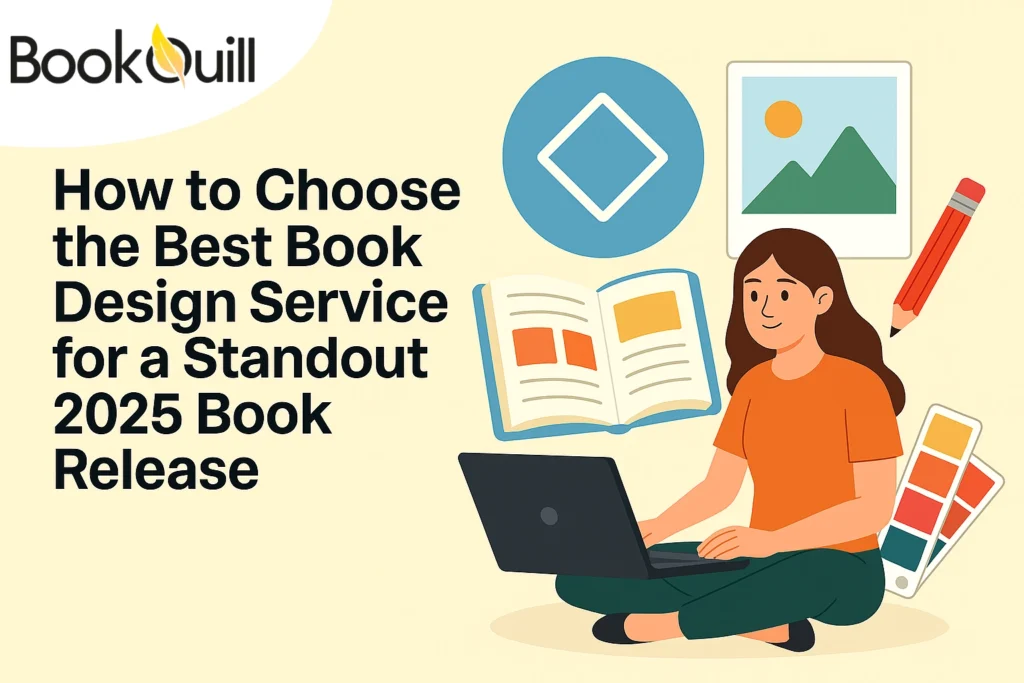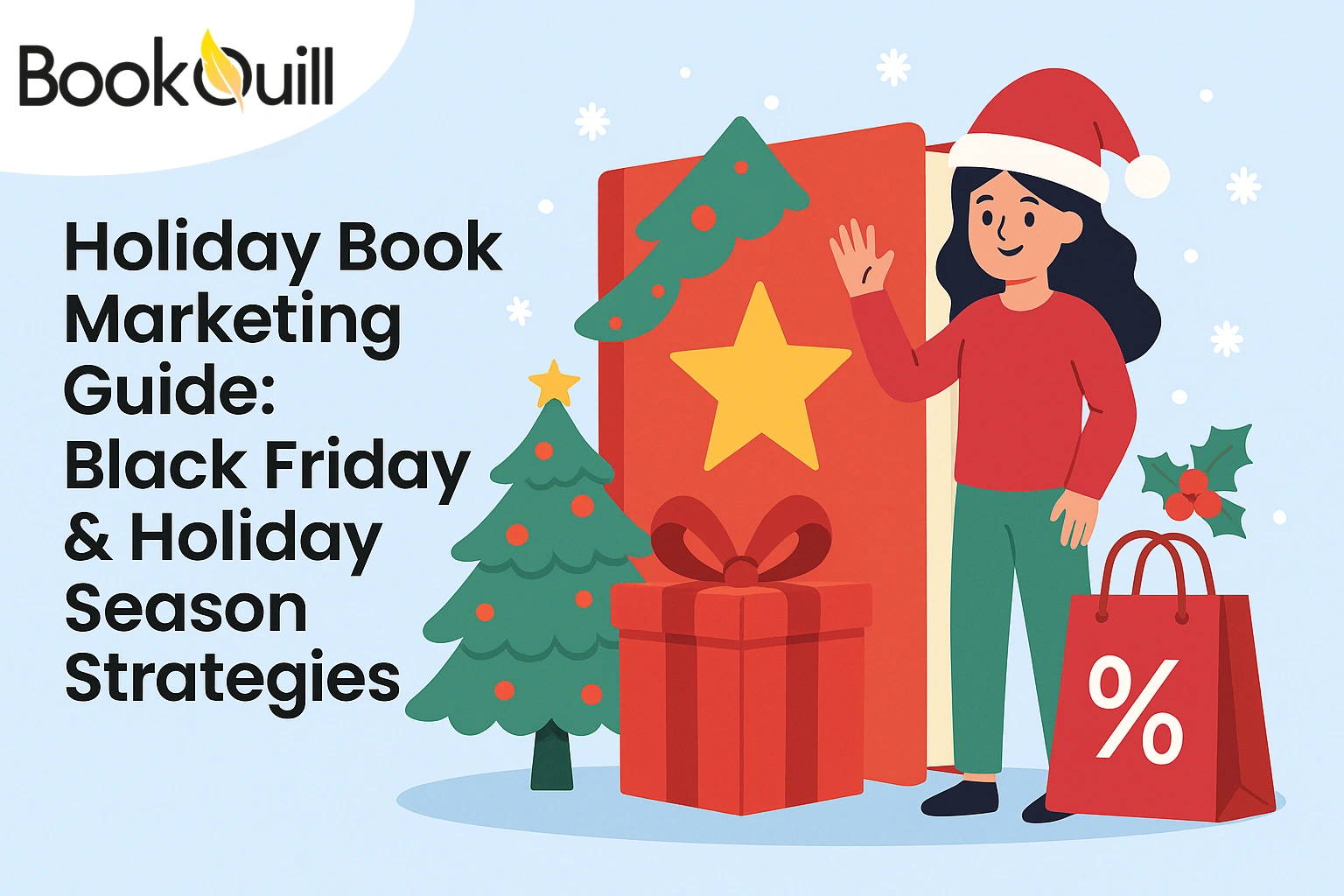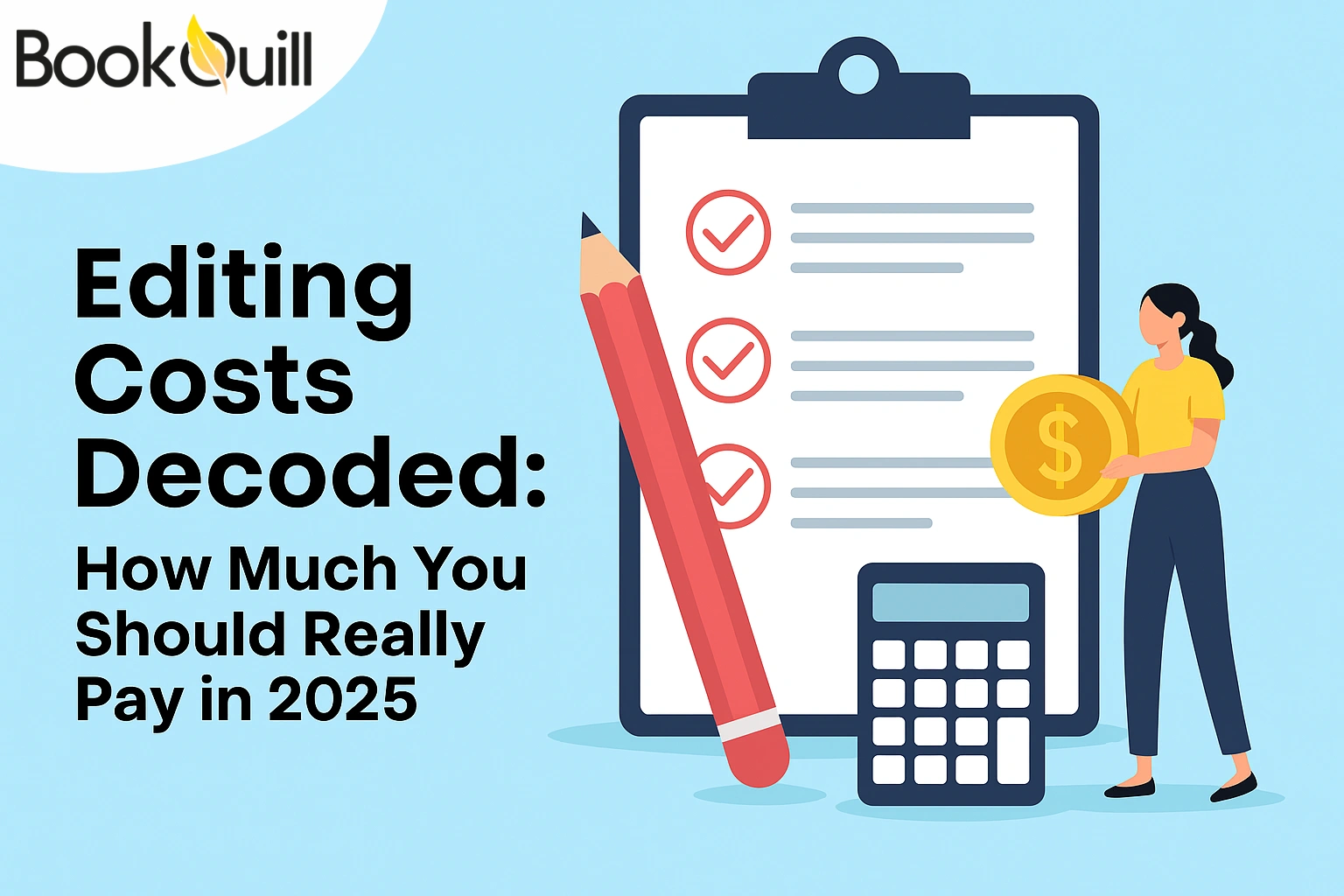Table of Contents
Explore Blogs
Trending on Ebook
How to Choose the Best Book Design Service for a Standout 2025 Book Release

You’ve got a great idea locked inside your manuscript, but now you need a cover that shows it off. In a busy 2025 book market, your cover is like a first impression with readers. Pick the wrong one, and they’ll skip over your book. Pick the right one, and they’ll stop, click, and want to know more. That’s why choosing the best book design service isn’t just a nice extra; it’s something you really need.
In this post, you’ll learn how a book cover can turn curious readers into buyers, how the pros can turn your ideas into amazing artwork, and who fits best into the process. Whether you’re working on a self-help guide, a memoir, or a fantasy debut, this is your map to finding a design that truly represents your vision. So, take a look!
Key Takeaways
- Start with why your cover matters. Your cover is your book’s first impression. It can instantly attract or lose a potential reader.
- Understand what good design does. A professional cover boosts visibility, click-throughs, and credibility.
- Know the key design elements. Typography, color, imagery, and layout each play a role in shaping mood and signaling genre. Every visual choice communicates what kind of story readers can expect.
- Choose experts who combine art and marketing. They understand audience psychology, publishing standards, and how to turn your vision into a market-ready product.
- Pick someone who knows your genre. Each genre has visual cues that readers expect. A designer experienced in your category will know how to balance creativity with those expectations.
Good design is teamwork. Share clear feedback, stay open to ideas, and communicate often. The best results come from collaboration, not control.
Ask the right questions.
Before hiring, confirm details like genre experience, revision rounds, design rights, file ownership, and turnaround time. Clarity prevents misunderstandings later.
Why Best Book Design Matters for Your 2025 Book Release
Your cover is your first handshake with readers. It’s often the only chance to make them pause, click, or turn the page. With thousands of titles being released every month, design can make the difference between being seen and being scrolled past.
The Power of a Strong Design
A polished design helps your book stand out on digital storefronts, builds trust, and conveys professionalism. It tells readers, “This is worth your time.” In fact, redesigned covers increased click-through rates by 51 % on average over the original versions in A/B tests. Meanwhile, surveys show that 57 % of people buy a book based on the cover, and 80 % avoid a book for the same reason if its cover fails to appeal.
Bookshelves and online marketplaces are visual battlegrounds. Good design gives you a fighting chance. Here’s how the best book cover helps:
- Your cover gives the reader a first impression before they even read your blurb
- It signals your genre, tone, and author professionalism
- It can boost discoverability and click-through rates
- It contributes to your long-term author brand
- It helps you compete, even among top book covers in saturated niches
Key Elements of the Best Book Design
A good book cover, for many, is just a piece of decoration. But in reality, it is a mode of communication. Every color, font, and visual cue tells your reader what to expect inside. Let’s break down the elements that make up the best book design in 2025, with real-world examples to make it simple.
1. Typography That Speaks Your Genre
Your font choice shapes emotion faster than words can. Serif fonts (like Baskerville or Garamond) often suggest classic, serious literature, while sans-serif fonts (like Futura or Helvetica) give a modern, fresh vibe.
For instance, the cover of Atomic Habits by James Clear uses clean typography to project clarity and simplicity, mirroring its self-improvement message.
2. Color Psychology and Contrast
Color builds mood. For example:
- Blue suggests calm or authority
- Red sparks energy
- Yellow radiates optimism
If you’re making a self-help book cover, warm colors can make it feel friendly and motivating. A thriller cover might use dark colors to make it feel tense or mysterious.
Example: The Gone Girl cover’s muted black and orange palette instantly signals tension and mystery.
3. Imagery and Illustration
Do you want people to gain some understanding of your book without reading a single word?
Yes?
Then you need stunning visuals for that. This is where custom book illustration services really shine.
Renowned fantasy series like “A Court of Thorns and Roses” by Sarah J. Maas stand out because of their rich, illustrated details, giving readers a visual identity to remember. If your story depends on world-building or symbolism, a top book illustration service can make all the difference.
4. Layout and Spacing
Ever seen a book cover crammed with too much text or too many images? It gets overwhelming fast and can turn readers away. A good cover keeps things clean and balanced with
- Enough breathing room,
- A layout that naturally guides the eye
- A title that stays clear and readable
Since most people now browse and read books on their phones, your cover needs to work at smaller sizes too. Think of someone scrolling through a bookstore app on their lunch break. They do not have time, and they are only skimming. Their purchase decision will be based on that skimming (that’s just how people are these days).
Within a matter of a few minutes, you have to catch their attention. You can not do that if your design is messy, spacing is bad, or the font is small. This might sound brutal, but they will scroll past your book.
5. Consistency with Branding
If you plan to write more books, consistency is key. Think of authors like Colleen Hoover or Brandon Sanderson, readers can spot their covers from across a shelf. That’s branding through design.
How Book Design Services Help with That
You’ve got the vision — now you need experts who can translate it into visuals that sell. Book design services do more than make things look pretty; they blend creativity, marketing psychology, and publishing standards to help your book perform in the real world. Let’s look at how they actually do that.
Translating Your Ideas into Visuals
A skilled designer doesn’t just ask, “What colors do you like?” They dig deeper. They’ll study important things before sketching the first concept, including your:
- Story
- Target audience
- Genre
For example, some professional teams often start by analyzing your reader demographics and mood boards, ensuring the design feels like your book before it looks like one.
In short, they turn abstract ideas into visual hooks that grab attention in crowded marketplaces like Amazon or Goodreads.
Industry Knowledge and Technical Expertise
A professional book illustration service understands industry standards like trim sizes, spine width, bleed lines, and KDP print requirements. These details can make or break a self-published release.
Many self-published authors run into problems simply because their files don’t meet the required specs. A professional service helps avoid those issues by making sure your cover and layout are ready for both print and digital formats, with no last-minute surprises.
Genre-Specific Strategy
Every genre follows unspoken visual rules. A fantasy reader expects lush illustrations; a business reader expects clarity and authority. A good designer knows these codes.
So, if you’re working on self-help book covers, they’ll lean toward brighter tones, strong titles, and minimalism. At the same time, a sci-fi designer might prioritize bold type and surreal imagery. It’s design that speaks the right language to the right crowd.
Collaboration and Revision Process
The best design relationships are collaborative. You’ll review drafts, provide feedback, and refine together. Many top services (like 99designs) even host design contests so you can compare multiple concepts before choosing your favorite.
It’s not just about “getting a cover.” It’s about shaping a visual identity that matches your author brand.
Understanding the Process of Working with Book Design Services
Hiring a designer can feel intimidating if it’s your first time, but once you understand the process, it’s surprisingly smooth. Most book illustration services websites and agencies follow a clear, collaborative structure that helps bring your vision to life, step by step.
1. Discovery Phase: Getting to Know Your Story
This is where everything starts. You’ll share your:
- Book synopsis
- Audience insights
- Goals
Some designers may even ask for sample chapters to feel the tone.
The goal is to understand what makes your book unique. A memoir about resilience, for instance, will look completely different from a fantasy epic or a children’s picture book.
Many designers also take time to study other successful books in their genre during this stage. Looking at top-selling titles helps them understand what kind of design styles attract readers — whether it’s a certain color scheme, font style, or layout. This doesn’t mean copying, but finding what works and using that insight to make your book feel both competitive and unique.
2. Concept Creation: Turning Vision into Direction
Once your ideas are gathered, designers start developing concepts, often presenting:
- Mood boards
- Sketches
- Early digital drafts
For example, if you’re publishing a self-help book, they may test color palettes that convey optimism and clarity, like soft oranges or clean whites.
This stage helps narrow the design direction before investing time in fine details.
3. Feedback and Revisions: The Collaboration Stage
Now comes the back-and-forth. Designers expect feedback; that’s part of the process. You’ll comment on fonts, imagery, and balance, while they refine accordingly.
Top services like 99designs or Reedsy usually include 2–3 revision rounds in their standard packages, so you can tweak confidently without worrying about extra costs.
Remember to be specific in feedback.
❌Instead of saying, “I don’t like it,”
✔️Try: “The title font feels too bold; can we try a lighter version?”
That helps designers translate your thoughts into action.
4. Finalization and Delivery: Your Book, Ready to Shine
Once your design is approved, the designer will send over the final files in formats suited for both print and digital use. Here are some file type deliverables:
| Purpose | File Types | Details |
|---|---|---|
| PDF, PNG, source files (AI, PSD) | Includes full cover spread: front, spine, and back, sized to your printer’s specs. | |
| eBook | JPEG (usually 1600×2560 or similar) | Optimized for online platforms like Kindle, Kobo, and Apple Books. |
| Audiobook | JPEG or PNG (square format) | Commonly used size: 3000×3000 pixels for platforms like Audible. |
If you’re also publishing digitally, they’ll adapt the same design for eBooks or audiobooks, ensuring consistency across platforms. Many professional book illustration services also offer add-ons like banner graphics, social media mockups, and marketing visuals for your launch campaign.
Choosing Between Freelancers, Agencies, and Platforms
When it comes to hiring a designer, the choice isn’t just about price; it’s about workflow, flexibility, and creative chemistry. Each option offers something different, depending on how hands-on you want to be and how unique your project is.
Freelancers: Flexible and Personalized
They are perfect if you want a close, one-on-one collaboration. They’re often more affordable and responsive, giving you direct creative input.
Pros:
- Lower costs and flexible terms
- Direct communication with the designer
- Personalized creative process
Cons:
- Quality varies greatly
- Some freelancers may lack consistency or reliability if overbooked
Best For: Indie authors, first-time writers, or small-budget projects that still want custom results.
Agencies: Structured and Full-Service
Agencies are ideal for authors who want peace of mind and a consistent brand image. They often combine designers, illustrators, and layout specialists under one roof.
They also cover interior formatting, ad creatives, and social media graphics, ensuring your book looks cohesive everywhere.
Pros:
- Team-based approach with multiple specialists
- Reliable timelines and clear contracts
- Great for authors planning a full series or rebrand
Cons:
- Higher upfront costs
- Less flexibility for spontaneous revisions
Best For: Established authors, publishers, or anyone wanting a full branding experience from one place.
Design Platforms: Variety and Competition
If you like exploring multiple creative directions before choosing, online design platforms are great. You post your project, and designers from around the world submit concepts. Then, you pick your favorite and work together to refine it.
Pros:
- Multiple options to compare before committing
- Transparent pricing tiers
- Built-in protection for your payment and files
Cons:
- Not every submission will match your taste
- Limited personal connection until you choose a designer
Best For: Authors who want to explore different visual ideas before making a final choice — perfect for those unsure of their creative direction.
Questions to Ask Before You Hire a Designer
Think of your designer as a creative partner, not just a service provider. You’re both working toward the same goal: a design that attracts readers and represents your book honestly.
The more open and transparent your early conversations are, the smoother your project will go.
Here are the key questions to ask:
Q1. Have you worked on book covers related to my genre before?
Experience in your category helps ensure they understand reader expectations and design norms.
Q2. What’s included in your package (and what costs extra)?
Clarify whether revisions, source files, or marketing materials are part of the price.
Q3. How many revisions do you offer?
Most professional book illustration services include at least two rounds. If not, ask for a clear revision policy.
Q4. Who owns the final design rights?
You should have full ownership once payment is complete. Always confirm this in writing.
Q5. Can I use the artwork for promotional materials?
Make sure you’re allowed to use your cover on ads, websites, and banners without extra fees.
Q6. What’s your average turnaround time?
Most book design projects take about 2 to 4 weeks, but detailed or custom illustration work can take a bit more time.
Q7. Do you provide layered source files for future edits?
This ensures flexibility if you later change your subtitle, logo, or author photo.
Q8. Can you design for both print and digital formats?
The best designers know how to optimize for both: print spine dimensions and eBook thumbnails.
Bonus Tip: If possible, ask to see case studies or before-and-after projects. This gives you a sense of how the designer handles evolution, not just the final result.
Ending Note
To sum up, choosing the best book design service isn’t about fancy visuals; it’s about finding the right creative partner who understands your story and your audience. In today’s competitive market, where millions of titles are published every year, your cover isn’t just decoration. It’s a sales tool, a conversation starter, and your brand’s first impression.
Whether you collaborate with a freelancer, hire an agency, or use a platform, take your time comparing portfolios and communicating expectations. Look for designers who listen, explain their choices, and welcome feedback. A great designer will never force a vision on you; they’ll build one with you.
When your design reflects both professionalism and personality, readers notice. And that’s when your book doesn’t just sit on the shelf, it moves. Your new release deserves to shine among the top book covers, drawing readers in with a single glance and keeping them there for every page that follows.
Frequently Asked Questions
How can I tell if my cover design is strong enough to sell?
Try testing your design with real readers or writing communities before publishing. Posting your mockups in places like Goodreads groups or Reddit’s r/selfpublish can give you honest, useful feedback. Even small design tweaks can make a big difference. In fact, professionally redesigned covers got about 35% more clicks on average compared to the original versions, even when the ad copy stayed the same.
Do I really need custom illustrations?
Not always. If your story depends on world-building, fantasy, or children’s visuals, custom book illustration services are worth the cost. For business or self-help books, a clean and professional photographic style usually performs better. It’s about matching the design to your content, not overspending on trends.
How far in advance should I hire a designer for a new release?
Ideally, 3–6 months before launch. Experienced designers, especially those offering the best book illustration services, tend to book out early. Starting early also gives time for revisions, marketing material design, and format adjustments for both print and digital.
Note: Some links in this post are affiliate links. If you buy through them, we may earn a small commission, at no extra cost to you. We only suggest tools we trust and find useful. Thanks for your support!
About Author
Hi, my name is Zachary Stone I’m a book marketing nut — or, as I like to call myself, a “Shelf Marketer.” No, I don’t sell wooden shelves; I market the books that are left forgotten on them. If you want your book to be the next bestseller, I am your go-to person. I am here to remind you that it’s not just about writing a great story — it’s about building a buzz among people with great campaigns.






